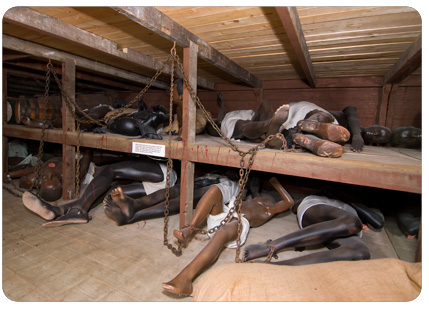
Griot Museum of Black History
Description
A man on the deck of a ship fights for his freedom, holding his captor’s arm behind his back. Another tries to climb the sails, escaping from the hold below where hundreds in chains look on. This model depicts life on a slave ship crossing the Middle Passage. Ships like this brought as many as fifteen million Africans to North and South America between 1500 and 1800. The first enslaved African to arrive in the British-American colonies was Angela, who came to Jamestown in August 1619. After Angela, around six hundred forty-five thousand slaves were brought to the United States as part of the triangular trade.
Historical Connections
In the triangular trade, European goods were shipped to Africa. Africans were then captured and shipped across what became known as the “Middle Passage” to the Americas. The slave ships would then pick up American goods and sell them to the Europeans. The triangle would thus begin again. Some of the materials exchanged for enslaved Africans included wool, cotton, refined sugar, distilled rum, and iron goods such as guns, chains, and branding irons.
Despite the captor’s constant attempts to break the spirit of those enslaved, there were cases where they failed. One of the best examples of slave rebellion was the Amistad mutiny. On June 28, 1839, Brother Cinque and fifty African captives on board the Amistad rebelled near Cuba. They told the Spanish owners to take them back to Africa, but the owners instead steered the ship to the United States. The U.S. Navy ship Washington spotted the slave ship, boarded it, and arrested the Africans as runaway slaves. The case went to the United States Supreme Court, where, on March 9, 1841, former President John Quincy Adams argued for eight and a half hours in defense of the Africans. The court ruled in favor of the Africans, and in 1842, Cinque and some of his comrades returned to Africa, settling in Sierra Leone. The Amistad is just one of multiple attempted slave rebellions, but it is arguably the most successful. The Supreme Court’s ruling was also an important legal step towards ending slavery.
top^
next artifact}
|

|



